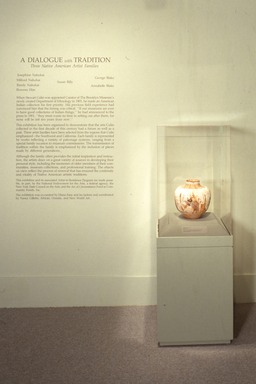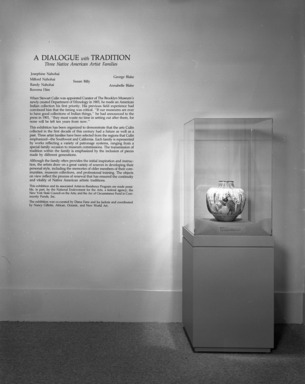
A Dialogue With Tradition: Three Native American Families
DATES October 04, 1991 through January 27, 1992
ORGANIZING DEPARTMENT
Arts of the Americas
COLLECTIONS
Arts of the Americas
-
July 1, 1991
The Brooklyn Museum will present an exhibition of works created by contemporary Native American artists from the Southwest and California who have actively sustained traditional crafts within their communities. Entitled A Dialogue with Tradition: Three Native American Artist-Families, the exhibition offers a rare opportunity for East Coast audiences to see the work of important artists who are widely recognized within their regions. It will open on October 4 and remain on view through January 27, 1992.
A Dialogue with Tradition is designed to complement the Museum’s major exhibition Objects of Myth and Memory, a historical exhibition drawn exclusively from the American Indian collections that Stewart Culin, the Museum’s first curator of ethnology, acquired in the field between 1903 and 1911. Including approximately 35 objects made between 1970 and 1991, A Dialogue with Tradition will dispel the myth of the “vanishing” Indian that inspired Culin’s fervent collecting and provide a contemporary Native American perspective of their traditional arts.
The exhibition will introduce three accomplished artist families from the Southwest and California, two geographic areas Culin emphasized in his collecting. The first section of the exhibition will present ceramics made by the Nahohai family of Zuni, New Mexico. In teaching her family, Josephine Nahohai has transmitted the traditional methods of pottery production, from collecting the clay on the mesa to firing the pottery in an open fire. Included will be works by Josephine, her sons Randy and Milford, and Randy’s wife Rowena that preserve and elaborate upon the ancient tradition of Zuni pottery design.
The second section of the exhibition will feature an impressive array of traditional Hupa-Yorok artifacts made by George Blake of northwest California. A variety of objects such as elegantly carved elk-horn spoons and purses, a sinew-backed bow, and spectacular featherwork regalia attest to his virtuosity in a wide range of traditional materials. A baby basket made by his wife, Annabelle, will also be on display.
The intricate craft of Pomo basket weaving is introduced in the exhibition’s final section by California weaver Susan Billy. In addition to her baskets, the exhibition will include a selection of pieces by Ms. Billy’s grandmother, Cruz I. Billy, and her great-aunt and mentor, Elsie Allen, one of the foremost practitioners of her craft. These works include simple utilitarian containers as well as fine feather-covered ceremonial baskets.
In conjunction with A Dialogue with Tradition, the Museum will present an Artist-in-Residence program in which the exhibiting artists will serve one-week residencies at the Museum demonstrating and discussing their artistry.
A Dialogue with Tradition was co-curated by Diana Fane and Ira Jacknis, Department of African, Oceanic, and New World Art, The Brooklyn Museum. The exhibition and its associated Artist-in-Residence program were made possible in part by the National Endowment for the Arts, a federal agency, and the Arc of Circumstance Fund in the Community Funds, Inc.
Brooklyn Museum Archives. Records of the Department of Public Information. Press releases, 1989 - 1994. 07-12/1991, 259-261.
View Original -
August 1, 1991
In conjunction with The Brooklyn Museum’s major traveling exhibition of Native American art, Objects of Myth and Memory: American Indian Art at The Brooklyn Museum, and its complementary exhibition, A Dialogue with Tradition: Three Native American Artist-Families, the Museum will offer a selection of programs for adults, families, and children. Included in the programs is the six-week series Native American Film and Video: A Walk in Two Worlds, which examines the wealth and diversity of film and video both by and about Native Americans; an important daylong symposium with internationally prominent guest speakers; an artist-in-residence program featuring the three artist-families from A Dialogue with Tradition; and a Native American storytelling series for all ages.
Saturday, September 7, 11 a.m.
STORIES FROM THE RED CEDAR CIRCLE
Education Division, 1st floor
Johnny Moses, also known as Whis Tem Men Nee (Walking Medicine Robe), is a youthful spiritual teacher and leader of the Red Cedar Circle. Through storytelling, song, dance, and ritual, he will offer an experience of the depth and richness of an original “New World” way of being. For all ages, with sign-language interpretation for the hearing impaired.
Sunday, October 6, 2 p.m., for adults
ARTIST-IN-RESIDENCE: SUSAN BILLY
Education Division, 1st floor
Ms. Billy, one of the country’s leading contemporary weavers, is among the group of Native American artists from New Mexico and California whose work is featured in the Museum’s exhibition A Dialogue with Tradtion: Three Native American Artist-Families. Specializing in the tradition of intricate Pomo basketry, she will demonstrate the materials and techniques of her art, discuss historical objects, and place her work in the continuum of Pomo tribal traditions.
Sunday, October 13, 2 p.m.
NATIVE AMERICAN FILM AND VIDEO: IDENTITY
Iris and B. Gerald Cantor Auditorium
This film and video program examines the Native American community’s struggle to find an identity while living in both Native American and American cultures. Guest speaker: Lloyd Oxendine (Lumbe), Curator of Contemporary Art, American Indian Community House Gallery.
Akuhtavahmaweeseeh: Red Dawn, 1987, Larry Cesspooch (Ute) of the Ute Indian Tribe Audio-Visual, 20 minutes, video.
Honored by the Moon, 1990, Mona Smith (Dakota), 15 minutes, video.
In Our Language, 1982, Edgar Heap of Birds (Cheyenne), 6 minutes, video.
Navajo Talking Picture, 1986, Arlene Bowmman (Navajo), 40 minutes, film.
Return of the Sacred Pole, 1990, Michael Farrell, 28 minutes, video.
Sunday, October 20, 2 p.m.
NATIVE AMERICAN FILM AND VIDEO: HOPI VIDEO ARTIST VICTOR MASAYESVA, JR., IN PROFILE
Iris and B. Gerald Cantor Auditorium
The unique experimental work of Hopi video artist Victor Masayesva, Jr., is featured in this program. Part poem, part essay, part documentary, his tapes express a distinctly Native American aesthetic. Guest speaker: Victor Masayesva, Jr.
Pot Starr, 1990, 6 minutes.
SISKYAVI--the place of Chasms, 1991, 28 minutes.
Hopiit, 1982, 15 minutes.
Ritual Clowns, 1988, 18 minutes.
Saturday, October 26, at 10 a.m.
SYMPOSIUM: “OBJECTS OF MYTH AND MEMORY: AMERICAN INDIAN ART AT THE BROOKLYN MUSEUM”
Iris and B. Gerald Cantor Auditorium
This important daylong symposium will examine intellectual and ethical questions concerning ethnological collecting and early museum representations of American Indians. Participants in the morning session will place Culin’s collecting philosophy in a comparative and historical context and, in the afternoon session, will offer multiple perspectives on questions of connoisseurship and interpretation. Internationally prominent scholars, curators, and art dealers will participate. Funding for the speakers’ travel to the Symposium was provided by the Samuel H. Kress Foundation. The cost of the Symposium is $20 for nonmembers and $10 for members, senior citizens, and students.
Sunday, October 27, 1 p.m.
NATIVE AMERICAN STORIES FOR THE FAMILY
Education Division, 1st floor
In conjunction with Family Members’ Day, storyteller Stephanie L. Betancourt will narrate, while her family enacts Native American stories. With sign-language interpretation for hearing-impaired visitors.
Sunday, October 27, 2 p.m.
NATIVE AMERICAN FILM AND VIDEO: FOR YOUNGER VIEWERS AND FAMILIES
Iris and B. Gerald Cantor Auditorium
This special program of works for young viewers and their families, developed in collaboration with Lloyd Oxendine and the Native American Heritage Committee, is offered on the Museum’s Family Members’ Day and features Native American storytelling, with special emphasis on the role of the bear in two Native American tribes.
Why the Bear Clan Know Medicine, 1990, Aysha Quinn and John Sturgeon, 11 minutes, video.
Tiwa Tales: Little Filth and the Tlachees, 1990, Chuck Banner, Maggi Banner (Hopi), and Joseph Leonard Concha (Tiwa), 17 minutes, video.
I Am Different from My Brother, 1981, Tony Charles, director; produced by the Native American Public Broadcasting Consortium, 20 minutes, video.
Bear Dance, 1988, James Ciletti, 13 minutes, video.
Saturday, November 2, 2 p.m., for adults
Sunday, November 3, 11 a.m., for families
ARTIST-IN-RESIDENCE: THE NAHOHAI FAMILY
Education Division, 1st floor
Randy, Rowena, Milford, and Josephine Nahohai are a family of artists nationally renowned their Zuni pottery. They are one of a group of Native American artist-families from New Mexico and California whose work is featured in the Museum’s exhibition A Dialogue with Tradtion: Three Native American Artist-Families. They will demonstrate the materials and techniques of their art, discuss historical objects, and place their work in the continuum of Zuni tribal traditions. Following the demonstration, adults and children can work together in a hands-on workshop. For reservations call (718) 638-5000, ext. 230.
Sunday, November 3, 2 p.m.
NATIVE AMERICAN FILM AND VIDEO: EXPERIMENTATION
Iris and B. Gerald Cantor Auditorium
These film and video works reflect the diversity of aesthetic styles and interests of Native American makers experimenting with form and technique. Guest speaker: Elizabeth Weatherford, Head, Film and Video Center, National Museum of the American Indian.
Intrepid Shadows, 1966, Al Clah (Navajo), 18 minutes, silent film.
That Which Is Between, 1989, Mona Smith (Dakota) and Nan Toskey, 8 minutes, video.
Sharp Rocks, 1988, Pierre Lobstein and Edgar Heap of Birds (Cheyenne), 6 minutes, video.
Surviving Columbus, 1990, George Burdeau (Blackfeet) and Larry Walsh, 30 minutes, video.
Sunday, November 10, 2 p.m.
NATIVE AMERICAN FILM AND VIDEO: NATIVE AMERICAN WOMEN SPEAK
Iris and B. Gerald Cantor Auditorium
The voices and visions of Native American women are highlighted in this program. Guest speaker: Kamala Cesar (Mohawk), Artistic Director, Lotus Fine Arts.
Ten Dollars of Nothing, 1989, Sara Diamond, 11 minutes, video.
Wind Grass Song: The Voice of Our Grandmothers, 1989, Jana Birchum and Tori Breitling, 20 minutes, film.
In the Heart of Big Mountain, 1988, Sandra Johnson Osawa (Makah), 28 minutes, video.
To Protect Mother Earth, 1989, Joel L. Freedman, 59 minutes, film.
Saturday, November 16, 3 p.m.
STORIES OF THE EARTH
Education Division, 1st floor
Donna Couteau from the Sac and Fox Nations and her husband, Joe Cross, of Kaddo/Potawatomi, will honor the earth through a combined storytelling-performance program, concentrating on stories from the Southwest. With sign-language interpretation for hearing-impaired visitors.
Sunday, November 17, 2 p.m.
NATIVE AMERICAN FILM AND VIDEO: POLITICAL ACTIVISM
Iris and B. Gerald Cantor Auditorium
Two issues have dominated the political struggles of Native Americans: land claims and freedom of religious expression, basic rights that they are still fighting for. Guest speaker: Tonya Gonnella Frichner (Onondaga), attorney and President, American Indian Law Alliance.
Our Sacred Land, 1984, Chris Spotted Eagle (Houma), 28 minutes, film.
The Spirit of Crazy Horse, 1990, James Locker, 58 minutes, video.
Leonard Peltier, 1989, Hart Perry, 4 minutes, video.
Saturday, December 7, 2 p.m. for children
Sunday, December 8, 2 p.m. for adults
ARTIST-IN-RESIDENCE: GEORGE AND ANNABELLE BLAKE
Education Division, 1st floor
The Blakes, who specialize in creating ceremonial objects, featherwork, basketry, and Yurok carving, are one of a group of Native American artist-families from New Mexico and California whose work is featured in the Museum’s exhibition A Dialogue with Tradtion: Three Native American Artist-Families. They will demonstrate the materials and techniques of their art, discuss historical objects, and place their work in the continuum of Yurok tribal traditions. Following the demonstration, children can participate in a hands-on workshop. For reservations call (718) 638-5000, ext. 230.
Brooklyn Museum Archives. Records of the Department of Public Information. Press releases, 1989 - 1994. 07-12/1991, 262-267.
View Original
